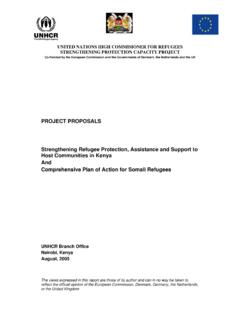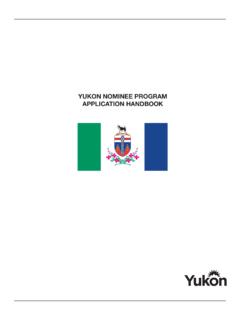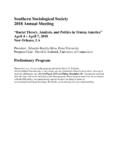Transcription of Hiring refugees - What are the opportunities and ...
1 Migration Policy Debates OECD/UNHCR, N 10 September 2016 1 In 2015, the number of refugees and asylum-seekers entering Europe reached record levels. In just a few months, more than a million people, the majority fleeing war, violence and persecution, made the perilous journey across the Mediterranean into Europe. As these trends continue in 2016, it is imperative that all actors public and private recognise and adjust to this new reality and contribute to making integration work. Recognising the challenges of integration, and building on their collective experience in this area, UNHCR and the OECD wish to jointly support the successful labour market integration of refugees . While public policies play a key role in facilitating the integration process, the private sector can make a critical contribution by training and employing refugees .
2 Therefore, it is essential to engage the business community, learn from its experiences and hear its concerns. This edition of Migration Policy Debates presents the first findings of a joint consultation process with employers started by the OECD and UNHCR, in order to: enhance understanding of the challenges faced by employers when employing refugees ; identify good practices in overcoming them; and provide inputs into strategies and approaches being developed by participating businesses and organisations. _____ Hiring refugees - what are the opportunities and challenges for employers? Unprecedented numbers of asylum seekers came to the OECD in 2015, and many of them will be recognised as refugees or receive complementary protection. Their labour market integration, however, will take time and to a large extent depends on employers being able to recruit and integrate them in their workforces.
3 In order to better understand the challenges employers face in Hiring asylum seekers and refugees and to design appropriate policy responses, UNHCR and the OECD co-organised a series of dialogues with employers and employer associations. Key findings include: Many employers do not see an immediate business case for Hiring refugees or asylum seekers. Particularly among larger employers, the main motivation for employing refugees is currently corporate social responsibility, rather than meeting labour needs. While many employers are willing to support refugees through training and internships, Hiring especially into more skilled occupations has so far been limited. Employers cite several reasons for the slow up-take of employment of refugees and asylum seekers, ranging from; uncertainty about the rules governing the refugees and asylum seekers rights to labour market access, and uncertainty about their skills and qualifications, to lower productivity due to a lack of host-country language skills, at least initially, and a public opinion that is sceptical about Hiring refugees or asylum seekers.
4 In order to overcome these challenges, employers would benefit from: o Assessment of asylum seekers and refugees skills, ideally in co-operation between employers and the public employment service, with subsequent upskilling provided where needed, and with a specific focus on shortage occupations, o More transparent and more accessible information on refugees right to work, the recognition of foreign qualifications and the availability of training support for refugees , including through one-stop shops and hotlines, o Stronger co-operation between public employment services and social partners, to facilitate the matching process between refugees skills and local demand, and o Ongoing support after initial work placements to ensure long-term employability. N 10, September 2016 2 Migration Policy Debates OECD/UNHCR, N 10 September 2016 Introduction Since mid-2015, Europe has seen the arrival of a record number of asylum seekers.
5 Although not all asylum seekers will be recognised as refugees , host countries will have to find ways to integrate an unprecedented number of refugees into their societies and labour markets. While access to the labour market may be restricted by administrative ( work permits) and practical barriers ( language), refugees have the legal right to work in all OECD countries. For asylum seekers, the rights and obligations differ significantly from one country to another. Most countries, however, grant access to the labour market to some groups of applicants on certain conditions, including a prior waiting period, ranging between 2 months in Italy to 12 months in the United Kingdom. Exceptions include Australia, Canada, Chile, Greece, Mexico, Norway and Sweden, where some groups of asylum seekers have the right to work as soon as they have filed their asylum claims, but may face other obstacles to access work, such as a labour market tests.
6 Most favourable waiting periods for labour market access for asylum seekers, selected OECD countries, 2016 (in months) Source: Update of OECD questionnaire on the integration of humanitarian migrants 2015. Note: * Under certain conditions (see OECD 2016a for further details). Other beneficiaries of international protection, notably those with temporary or subsidiary status, may face some restrictions in accessing the labour market. However, in the European Union, these are limited by the qualification Directive. Access to the EU labour market is generally possible for beneficiaries of international protection, at least under certain conditions. Evidence from a special module in the 2014 European Union Labour Force Survey and other sources suggests, nevertheless, that it takes refugees and other beneficiaries of international protection an average of 20 years to reach similar employment rate as the native-born.
7 Labour market integration, however, differs significantly between countries and by year of arrival. Some beneficiaries of international protection tend to take much longer to integrate into the labour market, such as the very low-skilled, older refugees or those traumatised by war. At the same time, evidence from countries with longstanding experience in hosting refugees , such as Norway, suggests that most refugees enter into employment faster when labour market conditions are good and strong support polices for labour market integration are in place. Not surprisingly, this also applies to those OECD countries in which most refugees arrived through resettlement programmes ( Australia, Canada, and the United States).
8 Employment rate by immigrant category and duration of stay in European OECD countries, 2014 Source: EU-OECD (2016); European Union Labour Force Survey Ad-Hoc Module on the Labour Market Situation of Migrants and their Immediate Descendants, 2014. Reducing the time it takes for refugees and others in need of international protection to integrate into the labour market and achieve self-reliance in their host country is one of the key challenges for OECD countries in the context of the unfolding refugee crisis. It is therefore critical to assess the challenges and opportunities for the business community in employing refugees and asylum seekers, and to determine what type of support employers need in this process. UNHCR and the OECD have joined forces to set-up a series of dialogues with employers.
9 The first dialogue took place in Brussels in June 2016, with the support of the OECD Business Advisory committee (BIAC). The second dialogue took place in Copenhagen in September 2016 in cooperation with the employer associations from Northern Europe. Further regional meetings are scheduled in the coming months. Migration Policy Debates OECD/UNHCR, N 10 September 2016 3 Building on these shared experiences and knowledge, this brief takes stock of the opportunities and challenges for employers when Hiring refugees . It also outlines possible solutions, providing input into the strategies, approaches and mechanisms being developed at the national and international level to better support businesses in employing refugees in OECD countries.
10 The business case Companies interested in employing refugees cite numerous motivations, ranging from corporate social responsibility (CSR) to a desire to benefit from the new pool of labour available. While many companies are motivated and see the business case, practical obstacles such as language skills, cultural differences and issues related to the experience of forced displacement often stand in the way of employing refugees . These barriers seem to frequently override the benefits of having an enlarged work force, as perceived by companies. CSR-related motivations feature prominently in many larger companies as reasons for their engagement. Several companies referred to the importance of contributing to the efforts of governments and local communities to receive and integrate the large number of refugees arriving to Europe.












